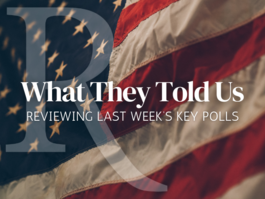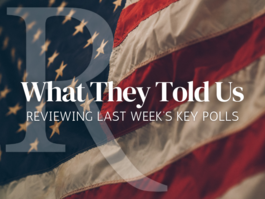The Crapshoot of Presidential Politics
A Commentary by Larry Sabato
This week's detour into the murk of racial politics underlines that it's going to be a long, hard slog on the Democratic side. The next opportunity for Democrats to resolve their deadlock will come in June, once the primaries are over and every state (and territory) has had its say.
And that is actually good news in a way. For once, Iowa and New Hampshire didn't get to pick the nominees by themselves, though they certainly still had too much influence for small, unrepresentative states--and they winnowed out some outstanding candidates too quickly.
On the surface of it, and the surface view is often the best view, Barack Obama is still the Democratic favorite over Hillary Clinton. The strong likelihood is that he will emerge as both the pledged delegate frontrunner (leaving the superdelegates aside), and the popular vote winner, once all the tallies from Democratic primaries and caucuses are included. The superdelegates, reason the Obama forces, will not overturn the popular-vote and elected delegate choice, for to do so risks a party conflagration. This is a powerful argument, and the current odds are that it will prevail, given the 2000 Democratic mantra of "let every vote count". But it must also be said that the argument ignores several possible pitfalls:
-
Superdelegates could begin cutting individual deals in June that bear no relationship to the national picture. This will shock our readers, but superdelegates are politicians and may well look out for themselves first. (We'll pause a moment to let you pick your jaw up off the floor.) Indeed, many superdelegates have already made firm commitments that contradict their state and local popular votes for president, and they show no signs yet of switching.
-
A scandal, gaffe or controversy could engulf one of the candidates, damaging his or her position in the polls against GOP nominee John McCain, sending superdelegates (and perhaps elected delegates, who are not obligated to support their candidate even on the first ballot) scurrying to the other candidate's banner. Clinton received tougher press coverage early in the contest. The scrutiny level has noticeably increased on Obama of late, and there's more than enough time left in this overtime battle for the press to turn on Clinton yet again. Uncommitted superdelegates have every reason to keep their powder dry.
-
Clinton or Obama could lose a key contest or two that they are expected to win before the end of the primary season on June 3. For Clinton this would have to be Pennsylvania on April 22nd, though every indicator now suggests that she will triumph there, perhaps handily. For Obama, there may be no absolute must-win, though North Carolina could come close on May 6th. The other battlegrounds could easily fall into the expected column. Besides the Keystone State, Clinton is thought to be likely to win West Virginia (May 13th), Kentucky (May 20th) and Puerto Rico (June 1st). In addition to North Carolina, Obama is believed to have the edge in Oregon (May 20th), Montana (June 3rd) and South Dakota (June 3rd). Indiana on May 6th will be an interesting election; potentially, it can be won by either side. Snuggled between Obama's Illinois and Clinton's Ohio, the demographics of the Democratic primary would lean to Obama, save for the state's most powerful Democrat, Senator Evan Bayh, a strong and early Clinton supporter who is on Clinton's short list for vice president. Could he be the Hoosier State's Ted Strickland (the governor of Ohio who delivered his state to Clinton)?
-
The Final Determination on Florida and Michigan Could Change the Calculus. The effort for a mail-in re-vote in Florida has predictably collapsed. It didn't serve the interests of the Obama campaign, and there were widespread doubts that the Democratic party in the Sunshine State could pull off a complicated, untested enterprise such as a statewide mail-in ballot without serious hitches. (Google "2000, presidential debacle in"--though to be fair, it was the state and local governments of Florida, not the Democratic party, that ran that historical howler eight years ago.) Now the re-vote in Michigan is off, too. Some solution must be found to seat delegations for the two states, lest the Democrats give the GOP a great issue for the fall campaign. The eventual resolution could roil the waters yet again, washing over the sandcastles of arguments built by the Obama and Clinton campaigns in the weeks prior and contributing to an intense season of super-spin to tilt the superdelegates.
The real votes will matter a great deal more than the substantially phony arguments now being trotted out by both camps. The Clinton forces say, "Hillary has carried almost all the big industrial states that a Democrat must have in order to capture the White House, including California, New York, New Jersey, Ohio, Texas (the primary at least) and, coming up, Pennsylvania." As any experienced election analyst knows, any Democrat is going to carry California, New York and New Jersey, and probably Pennsylvania (unless John McCain puts former Keystone State Governor Tom Ridge on his ticket).
No Democrat is going to carry Texas. So Clinton's argument is essentially about Ohio. True enough, Ohio is an absolutely critical swing state that made all the difference in the 2004 presidential election. But would it be the one and only critical state for the second election running? Florida didn't repeat in that role from 2000 to 2004. And might Obama not win it anyway, despite a loss in the March 4th primary, given the marked shift to the Democrats noted in the 2006 midterm elections in the Buckeye State?
Not to be outdone, the Obama consultants counter with this argument: "Only Barack Obama has the potential to carry the Republican Red and competitive Purple States that he has swept in his march to the nomination." The hard truth is--and apologies to the Obama dreamers--most of those states are nearly or completely out of reach. As long as the November 2008 election is reasonably close, Obama is not going to carry any of the Southern states he has won in primaries so far. Virginia is the only possible exception, and the Republicans have chosen the one candidate in John McCain most likely to hold the Old Dominion to its forty-year GOP presidential voting pattern.
Nor is Obama going to win Alaska, the Dakotas, Idaho, Kansas (absent Gov. Kathleen Sebelius on the ticket--and even then it's a stretch), Montana, Nebraska, Utah or Wyoming. A sizeable majority of Red states will stay Red and Blue states will stay Blue this November, regardless of the identity of the Democratic nominee. Obama might have his best argument to make about Colorado, a new swing state which appears more resistant to Clinton than Obama.
Why are the primaries and caucuses so different from the general election? It is for a simple, often overlooked reason. A reasonable, highly rounded estimate of all primary and caucus voters in all fifty states--projecting forward to June--might be about 40 million for the Democrats and 20 million for the Republicans. While many Independents participated in the nominating contests, overwhelmingly the voters were highly partisan Democrats and Republicans. A relative handful of partisans voted in the other party's contests.
This year, Obama has been the clear beneficiary of most of that "cross-over vote", though lately Clinton has received a slice, too. (Some Republicans vote in the Democratic primaries because the GOP race is over; some favor one of the Democrats because they genuinely like him or her; others are trying to nominate the candidate they regard as weaker for November.)
The Democrats have at least double the GOP number of votes because there is far more enthusiasm on their side in 2008, and because the Democrats are taking longer to pick a nominee. The GOP contest was resolved early, thanks mainly to the Republican winner-take-all rule in most states and districts. This Republican practice contrasts starkly with the ever-so-fair--maybe too fair--proportional representation of the Democrats. (Isn't it remarkable that a candidate can win a big swing state by a landslide margin, and emerge with only a half-dozen delegate majority? Have the Democrats ever considered giving some bonus delegates to the statewide winner in each state? They ought to do so in the future.)
The total of 60 million for all the nominating contests sounds like a lot, until you consider that in November, perhaps 130-135 million Americans will cast a ballot. Who are the extra 75 million voters in the fall? Some are Democrats and Republicans who did not show up for the winter and spring preliminaries, but a large chunk--forty million or so--are "swing voters" who can vote for either side. This number includes pure Independents, as well as so-called "weak Democrats and Republicans", who often stray from their party's column. These 40 million swing voters will decide the contest in every single hotly contested state.
Therefore, the party nominating results tell us surprisingly little about how a state will vote in the fall. The winter and spring party contests are generally a reflection of the views of partisans, who usually are not representative of the broader electorate. It is also a grave error to assume that the Independents voting in party primaries are representative of the much larger group of Independents and Independent-leaning citizens who will show up in November.
In short, both Democratic candidates are using dubious electoral arguments to promote their candidacies. Their primary showings do not predict the fall election. Of course, neither do today's public opinion polls forecast the fall results. It is far too early for the November horserace match-ups to have much meaning. Historically, one could argue that it will be a week or two after the second party convention--thus, this year, about mid-September--before the polls begin to be at all reliable.
Where does this leave the Democrats? They can't use either the primary returns or the polling numbers to tell them definitively which is the better candidate to defeat John McCain. Instead, they will have to rely on old-fashioned political judgment and hardheaded evaluations of the strengths and weaknesses of Barack Obama and Hillary Clinton to make their choice.
That's really the way it should be. Presidential politics is always a crapshoot. Despite the marathon primary campaign, and a wealth of election and polling data available to superdelegates, 2008 will be no different.
Larry J. Sabato is the director of the Center for Politics at the University of Virginia.
See Other Commentary by Larry Sabato
See Other Political Commentary
Rasmussen Reports is a media company specializing in the collection, publication and distribution of public opinion information.
We conduct public opinion polls on a variety of topics to inform our audience on events in the news and other topics of interest. To ensure editorial control and independence, we pay for the polls ourselves and generate revenue through the sale of subscriptions, sponsorships, and advertising. Nightly polling on politics, business and lifestyle topics provides the content to update the Rasmussen Reports web site many times each day. If it's in the news, it's in our polls. Additionally, the data drives a daily update newsletter and various media outlets across the country.
Some information, including the Rasmussen Reports daily Presidential Tracking Poll and commentaries are available for free to the general public. Subscriptions are available for $4.95 a month or 34.95 a year that provide subscribers with exclusive access to more than 20 stories per week on upcoming elections, consumer confidence, and issues that affect us all. For those who are really into the numbers, Platinum Members can review demographic crosstabs and a full history of our data.
To learn more about our methodology, click here.



